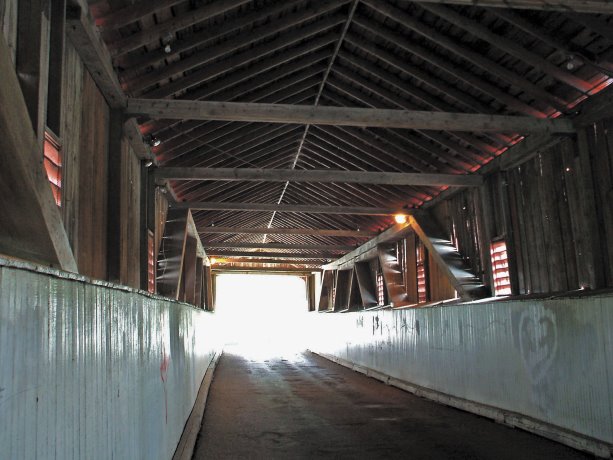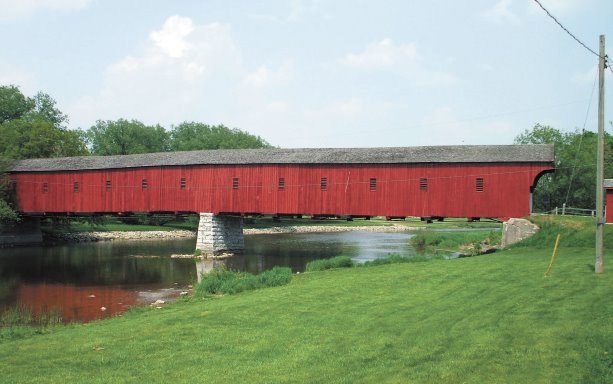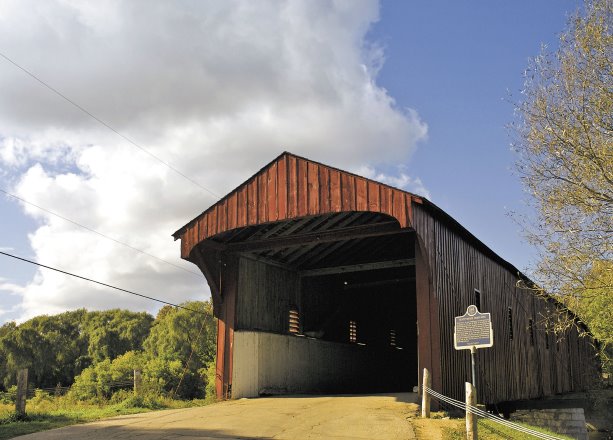The West Montrose covered bridge is Ontario’s only remaining covered bridge open to vehicle traffic. Careful maintenance and an eye for architectural detail are essential to preserving and maintaining the historic structure.
Brothers John and Benjamin Bear built the bridge in 1881 in West Montrose, about 20 kilometres north of Waterloo. It runs 20 feet wide and spans 198 feet as it crosses the Grand River. Minutes of the Woolwich Township Council note that the bridge was to be built of: "…good sound timber free from splits, shakes, large or loose knots or anything that has a tendency to impair its strength."
Why build covered? According to the Ontario Heritage Foundation, an uncovered wood bridge exposed to the sun and weather demonstrated an average lifespan of 10 to 15 years. A covered bridge typically lasted as long as 80.
The historic maintenance regimen included lighting coal-oil lanterns on either end of the bridge nightly, and spreading snow on the interior surface so as not to impede the passage of sleighs during winter.
The bridge was upgraded with concrete abutments in 1937, while its central pier — a wood crib filled with stone — was replaced with a brick and stone pier. The coal-oil lamps were replaced with electric lights in 1950 and in the mid-1960s two metal Bailey trusses were added to the structure and concealed behind tongue-and-groove paneling. The bridge also underwent a series of major repairs in 1999 and 2000.
Recognized as a historic site by Ontario’s Archeological & Historic Sites Board, the West Montrose covered bridge is still used for light traffic. Responsibility for the bridge now rests with the Region of Waterloo’s Transportation Division.
"It’s a single-lane bridge with a three-tonne load limit," says Shawn Buckley, Senior Transportation Infrastructure Engineer with the Region.
"However one of the main problems with the bridge is overloading, with some transport trucks and school buses using it, which is ridiculous. Even a 3/4-ton pickup carrying two people is close to the load limit.
"In 2012, what we suspect was an overloaded tractor broke one of the floor beams. An astute canoer on the Grand River looked up and reported the crack. We called in a consultant, shut the bridge down for three or four months and installed a new pressure-treated floor beam. That incident really called attention to the profile of the structure."
The bridge’s wood deck is made up of laminated two-by-fours set on end, and paved with a 25-mm layer of asphalt to protect the deck from traffic.
"That includes tires and horses’ hooves," says Buckley. "There’s a Mennonite store off to the side of one end of the bridge and there’s still a high level of horse traffic."
The bridge is inspected yearly due to its age and historic nature, twice as frequently as required by the province.
"We believe the condition of the bridge is good," says Buckley.
"The Baileys are doing most of the work of supporting the bridge, although the wooden trusses still play a role."
The Transportation Division has also assembled a thorough history of the bridge and its rehabilitation and maintenance. A preservation plan developed with input from consultants and stakeholder groups has identified a list of potential risks to the bridge, including overloading, lightning strikes and ice jamming.
"We’ve developed responses to the risks that are most likely to occur, keeping in mind that we maintain the heritage look and feel of the bridge," says Buckley. "Just last year we placed timber guide rails on all four corners of the approaches and it fits in really well. We’re also looking at installing decorative lightning rods, providing decorative lighting inside the bridge and adding fire detection equipment."
The Region recently hired a dry ice blasting company to clean the bridge interior. The areas behind the interior wood paneling must also be cleaned of animal waste every two to three years to prevent chemical damage to the wood trusses.
"It’s a fascinating ongoing maintenance project," says Buckley. "On which other road transportation project do you have to think about the proper way to shingle a roof?"

1/2
Photo:



Recent Comments
comments for this post are closed